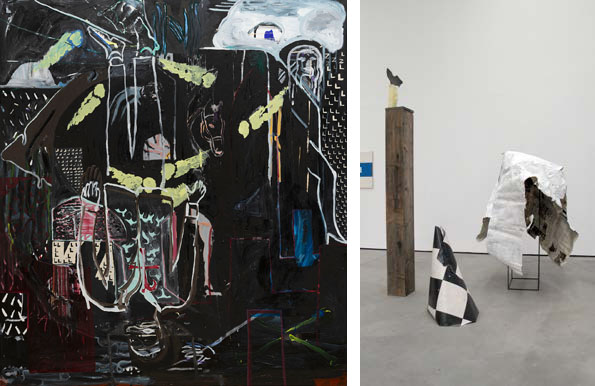The group show presents contemporary positions from Denmark with the disparate manifestations of minimalist abstraction as well as variants of new figuration such as “new bad painting”. The aim is not a superficial juxtaposition of these artistic approaches, but a reference to the covariance of structures, varieties and experimental fields within contemporary Danish art, which – especially in the compatibility of these simultaneous approaches – query the painting on its conditions and possibilities.
A reduction of painterly or artistic elements are represented in the exhibition with the abstract, minimally edited canvases of Lone Haugaard Madsen (*1974 Silkeborg / DK) and her likewise minimalist, but equally ‘emotional‘ installations in which she arranges, in the tradition Laurie Parsons, discarded, found objects amongst others.
The color-intensive works of Frederik Næblerød (*1988 DK) and Asger Harbou Gjerdevik (*1986 DK) are an obvious contrast. In line with the artistic approach of „bad paintings“ – in the sense of a deliberately relaxed painting style that has consistently been freed from normative specifications – both use an independent, skilfully sketchy abstracted imagery.
In his expressive paintings and drawings Frederik Næblerød takes a reference to social issues and the world of things – in a purposeful striking way: a fishing boat, a watering can, a bird. Not infrequently, the simplistic figurative representations, as well as his small-format sculptures, tilt over to the fantastic and grotesque.
On several levels, however, Asger Harbou Gjerdevik combines figurative content with abstract color elements and other materials on his large-format canvases in a collage-like overlay. Through the abundance of interrelated elements and partly scenic representations, he generates visual complexity and the suggestion of a narrative content.
In the current Danish art the abstract and concrete, the pictorial and expressive figuration not only stand side by side in their simultaneity. In the commenting Recourse to the various pre-/modernisms, these are brought into a new relationship and react with each other.


The group show presents contemporary positions from Denmark with the disparate manifestations of minimalist abstraction as well as variants of new figuration such as “new bad painting”. The aim is not a superficial juxtaposition of these artistic approaches, but a reference to the covariance of structures, varieties and experimental fields within contemporary Danish art, which – especially in the compatibility of these simultaneous approaches – query the painting on its conditions and possibilities.
A reduction of painterly or artistic elements are represented in the exhibition with the abstract, minimally edited canvases of Lone Haugaard Madsen (*1974 Silkeborg / DK) and her likewise minimalist, but equally ‘emotional‘ installations in which she arranges, in the tradition Laurie Parsons, discarded, found objects amongst others.
The color-intensive works of Frederik Næblerød (*1988 DK) and Asger Harbou Gjerdevik (*1986 DK) are an obvious contrast. In line with the artistic approach of „bad paintings“ – in the sense of a deliberately relaxed painting style that has consistently been freed from normative specifications – both use an independent, skilfully sketchy abstracted imagery.
In his expressive paintings and drawings Frederik Næblerød takes a reference to social issues and the world of things – in a purposeful striking way: a fishing boat, a watering can, a bird. Not infrequently, the simplistic figurative representations, as well as his small-format sculptures, tilt over to the fantastic and grotesque.
On several levels, however, Asger Harbou Gjerdevik combines figurative content with abstract color elements and other materials on his large-format canvases in a collage-like overlay. Through the abundance of interrelated elements and partly scenic representations, he generates visual complexity and the suggestion of a narrative content.
In the current Danish art the abstract and concrete, the pictorial and expressive figuration not only stand side by side in their simultaneity. In the commenting Recourse to the various pre-/modernisms, these are brought into a new relationship and react with each other.